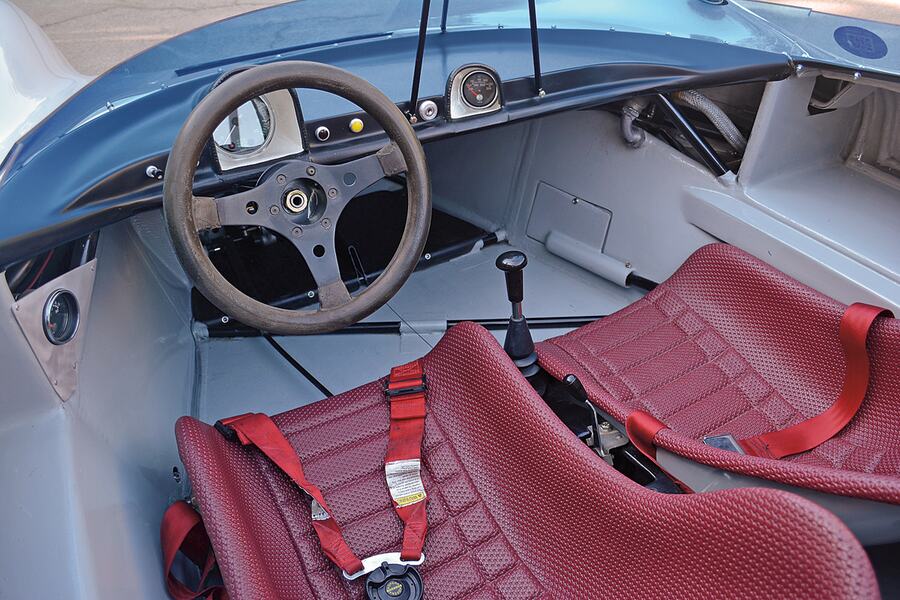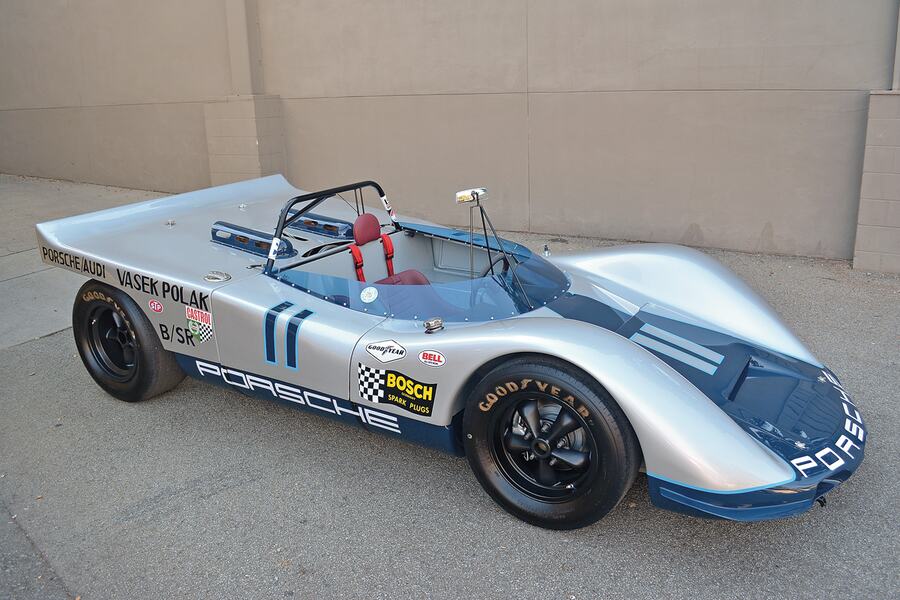To a passerby, the pile of steel tubing, aluminum panels, and fiberglass body parts baking in the desert sun probably looked more like the remnants of a 1970s kit car project than pieces of Porsche racing history. “A lot of people thought it was a dune buggy,” said Johnny Penner, who remembers the day his father, motorcycle racer and connoisseur of speed, John Penner, brought the car home. And while Penner senior knew that few would be able to identify the factory Porsche 906, he also knew what it was worth.
Before Penner acquired it, the car had passed through six owners and undergone several design evolutions. It began life as Porsche 906-136 and was raced by Don Wester of the Porsche Car Pacific, Inc. team in 1966. It was then sold to Lew Florence Motors. After that, the Bozzani racing team ran it for one year before selling it to legendary racer and car dealer Vasek Polak.
To keep the four-year-old car competitive, Polak, through his strong relationship with the Porsche factory, acquired upgraded parts. Alwin Springer, the team’s chief engineer, said in the book “Racing with Porsche in North America”, “We tried to make our 906 faster and incorporated quite a few parts from the 910: modified wheel carriers, lighter axle shafts, titanium wheel hub bolts, and many small parts.”
It also received a more powerful engine, which Polak bought from the factory. It featured a lightened crankshaft, titanium connecting rods, and a Bosch Kugelfischer slide-valve injection system. It’s believed those components were only used on four very select 906s. The identity and story behind the engine would be discovered over 15 years later. That powerplant would later be identified as the flat-six that motivated the Porsche 906-153 LH (longtail) that Jo Siffert drove to first in class and fourth overall at the 24 Hours of Le Mans in 1966.

Even with the upgrades, Springer and Dieter Inzenhofer, the team’s chief mechanic, believed the car needed to shed some weight to be competitive.
“We decided to turn the 906 coupe into a 906 Spyder,” said Springer. “No sooner said than done: we sawed off the roof and replaced the entire rear end with a lightweight, wedge-shaped top with a spectacular tear-off edge. Of course, our Spyder also needed new, small doors. In front of the cockpit, a low wind deflector ran all the way around to about the driver’s shoulders with a new, lighter nose that retained the original shape.”
The scales confirmed their success. The Spyder was 100 pounds lighter than the coupe. During their operation, they paid close attention to the fact that they could say they could undo all the changes, which in the coming weeks saved them from Vasek Polak’s wrath. In a recent conversation, Springer added, “It could have cost me my job. But you have to take chances, calculated risks.”
As an open-top model, the 906, driven primarily by Milt Minter, proved to be competitive. The Polak team won the B/SR class in the U.S. Champions race at Road Atlanta and SCCA National events in Bonneville and Phoenix in 1970 and the SCCA National in Holtville in 1971.

In 1971, Polak sold the car to Harald Kirberg. The Kirberg Motors team reworked the chassis with entirely different body shapes that featured hard angles and wedge-like shapes similar to the Can-Am racing cars of the day. It became known as the Kirberg Special and made its debut at Laguna Seca in 1972. It raced through the 1977 season by Kirberg with no notable results.
In the classifieds section of an Autoweek magazine in 1978, veteran motorsports journalist and Porsche historian Kerry Morse saw Kirberg’s ad for the car and contacted him. Hours later, he was driving a borrowed Ford Bronco with a borrowed trailer up to the Bay Area.
“I remember seeing the car when Vasek was running it in the early ’70s,” said Morse. “When Harald Kirberg had it for sale, by then, it had a third-generation body. It looked like a total Can-Am car. By then it had lost all identity of being a Porsche.” Morse planned to restore the car, but there was also interest from another buyer. However, the other buyer backed out when he saw the work required to bring it back to stock. Then, his good friend, the aforementioned John Penner, also became interested.
“He thought it would be great to buy 906-136, the Kirberg Special, in the condition it was and go out racing,” says Morse. “Ontario Speedway was still there. I remember going out there with him in the car to do the shakedown on it. And, uh, it was quick. The rubber on it—Kirberg had modified the car so much that it had outrun every 910 you could come up with. And it would probably give a 907 and a 908 a run for its money. One, it was lighter, it was more aerodynamic, and it had a helluva lot more rubber.”

Penner’s son, Johnny, also remembered going to the PCA time trials at Riverside and Ontario with his father. “For him,” the younger Penner said, “coming out of a 911 street car (the Kirberg Special) was on rails.” They would run the car a few more times before it sat dormant in a storage area of a property Penner owned.
In the mid-1980s, while Morse was on a work/business trip in Europe, he met a gentleman who said he owned Porsche 906-153, the car Jo Siffert raced to a first-in-class victory at Le Mans in 1966.
“Vasek had obtained that engine from Porsche, along with his usual containers full of spares,” said Morse. “They just cleaned out. That’s how Vasek built up his inventory of obsolete parts from the factory.” Polak had that engine in 906-136 when Alwin Springer converted it to a Spyder. Of course, they didn’t know back then that engine came from the first factory longtail 906 that also won its class at Le Mans. There were four longtails, but only three ran at LeMans for the race. Porsche 906-153 was the trick car for Siffert.
“At the time, in doing the research on the (Jo Siffert) long tail, I got the race records of the car, and I noticed that the engine number was for a 2.0-liter mechanically injected twin-plug 906 901/21 engine, and ironically, the Polak/Kirberg car had that engine in it,” continued Morse. “I wanted to reunite the original engine from Porsche 906-153 that ran in LeMans back in the long tail. So I made a deal with Penner that I would supply a body in trade and another carbureted engine, stock Porsche 906, that was originally the type that would have been in Porsche 906-136 when the car was bought by Don Wester. So we made the deal.”

The engine was reunited with the original 906-153 chassis, and what remained of Penner’s Spyder/Kirberg Special after 906-136 was restored back to a coupe stayed on his property, sometimes stored in a warehouse on the property, sometimes left outside for the better part of 20 years, according to the younger Penner.
“Kerry Morse had told me the special chassis parts that Alwin Springer had made were out in the desert, and he sent me pictures encouraging me to go take a look and consider it as a project,” said Ed Palmer, the owner of Kundensport, a Porsche restoration shop in Santa Paula, California. “It took a few years, but I was finally able to purchase it from Johnny Penner.
Palmer planned to bring the 906 back to the Spyder specs, believing the car should be restored to the period when it was most successful. Fortunately for him, this wouldn’t be his first 906 rodeo as he had restored one before, and, it just so happened, he had a customer’s 906 in his shop for paintwork. On top of that, he had a complete, tired-but-straight 906 chassis and factory blueprints that Morse sourced.
The car also came with three sets of body panels: a few from the original coupe, the Spyder, and the Kirberg Special body panels. They were complete—in rough shape—but all there. He did, however, need a transmission. Palmer credits Morse with somehow finding a new magnesium Porsche 906 transmission from a foundry in Italy that included a main shaft from a Porsche 904 and a complete set of gears.

Palmer soon discovered that a majority of the work would be un-doing the changes the Kirberg team had made to the front suspension and areas that the Kirberg team had changed to mount their body panels. In some areas, the Kirberg team added boxed reinforcement tubing over the original thin-walled metric tubing and changed the mounting points of the control arms.
Luckily for Palmer, the men who knew most about the changes and could guide him back to Spyder spec were just a couple of phone calls away. Alwin Springer and Dieter Inzenhofer, the two Polak race team members responsible for the conversion, were happy to help.
“I was pleasantly surprised when Kerry told me it was being restored,” said Springer. “Of course, I was wondering what happened to the car, but I was occupied.” With the Polak race team moving on to the 917 and then he and Inzenhofer starting Andial a few years later, there were other things to think about.
“Alwin was able to assist with the type of suspension, titanium parts, how the body was set up, and the chassis modifications that were made,” said Palmer. He advised on the proper paint colors (Aga Blue and Porsche Silver 936) and was also a stickler about the rearview mirror. Dieter came by and went over the car with me.”
The engine was sent to SuperTech in Fallbrook, California, and rebuilt, while the 906E Bosch Kugelfisher slide-valve mechanical fuel injection system was refreshed by Pacific Fuel Injection in South San Francisco. With the goal of showing the car at the Rennsport Reunion in 2023, Palmer and his team dove in and logged countless 16-hour days for over a year to make the deadline.
Its debut at Rennsport certainly jogged the memory banks of those who had seen the 906 run in the early ’70s, with many coming up to Palmer with their personal remembrances. Unlike other cars that slipped through the cracks and have been lost or forgotten, this one came back thanks to the dedication, resolve, and expertise of a handful of enthusiasts and the men who dared to make it faster.







